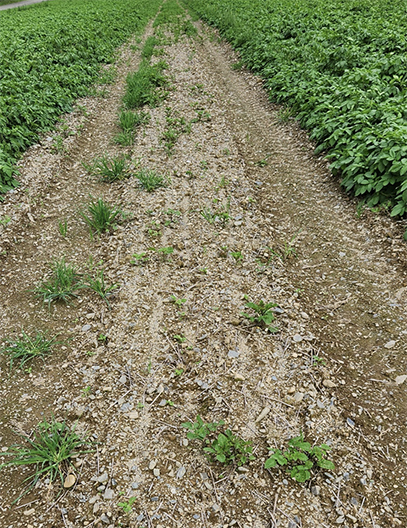Bulletin #1090, Management of Volunteer Potatoes in Maine
By I. Kutay Ozturk, Extension Potato Pathologist, University of Maine Cooperative Extension
Reviewed by Andrew Plant, Maine Potato Board, and Jay Hao, Associate Professor of Plant Pathology, University of Maine
For information about UMaine Extension programs and resources, visit extension.umaine.edu.
Find more of our publications and books at extension.umaine.edu/publications/.
Volunteer potatoes are potato plants growing from the tubers left in the field from the previous season. In Maine, volunteer potatoes are a significant weed problem as they can be sources of diseases such as late blight and viruses.
A study from Michigan State University (1) showed most of the volunteer potatoes in the field are eliminated during prolonged exposure to temperatures below 27°F, however, the tubers deep in the soil could be insulated enough to survive the winter. Therefore, volunteer potatoes pose bigger threats following mild winters. A study from U.K. showed that up to 150,000 volunteer potatoes per acre are left behind after harvest, 10% of which stays viable (2). Surveys on the potato-growing regions of Maine showed that approximately 3,000 volunteer potatoes per acre in rotation crops were observed in 2020 and 2021, and approximately 1,000 per acre were observed in 2022, after the cold winter of 2021-2022 (Andrew Plant, unpublished).
Management of volunteer potatoes requires an integrated approach of cultural and chemical methods. Volunteer potato management begins in the fall and continues in the spring and will likely require multiple interventions due to the large energy reserves tubers store below the ground.
Managing volunteers in the fall
Management of volunteer potatoes starts during harvest, and steps taken in the fall will help greatly in reducing the number of volunteer potatoes heading into the winter. The fall strategies for volunteer tuber management are built upon on the idea of exposing the tubers left on the soil surface to cold weather from the winter as much as possible, thereby facilitating the tuber freezing.
- Shallow tilling or delaying the tillage until spring to prevent volunteer potatoes from being buried deep in the soil before the winter.
- Narrowing pitch spacing during harvest to reduce the number of potatoes left on the field.
- Withholding from spreading large quantities of organic materials on top of tubers.
- Spread cull potatoes thinly on the soil surface to expose them to freezing temperatures.
Managing volunteers in the spring & summer
While the fall management strategies can greatly help in reducing the spring and summer workload, volunteer potato management will likely need to continue during the growing season. The spring and summer management strategies focus on killing the emerged volunteer potatoes, preventing re-sprouting, and preventing or at least hindering the new tuber formation.
- Application of sprout inhibitor maleic hydrazide towards the end of the season assists with the reduction of volunteer potatoes the following season, however, its effectiveness is highly dependent on the variety, tuber size, and environmental conditions.
- Post-emergence herbicide applications should be aimed toward the tuber initiation phase, by closely following labels for allowed crops, rates, application timings, and crop rotation restrictions.
- When practical, repeated cultivations and hand weeding can assist in the control of volunteer potatoes.
- Consider incorporating glyphosate-resistant crops into rotation programs.
- After grain harvest, consider the application of glyphosate for several weeks post-harvest to the fallow field to eliminate volunteer potatoes emerging late in the season.
- In situations where herbicides cannot be used, a minimum of four cultivations are recommended, starting when the volunteer potato plants are 3-6 inches tall.
- Monitor rock piles for volunteer potato emergence in spring and summer.



Figure above: Volunteer potatoes in a fallow alley. Depending on the depth of the tuber left behind, volunteer potatoes emerge at different times of the season, making management difficult.
Resources
- canr.msu.edu/news/potential_survival_of_potato_volunteers_in_mich
- Lutman, P.J.W. 1977. Investigations in some aspects of the biology of potatoes as weeds. Weed Research 17:123-132.
Information in this publication is provided purely for educational purposes. No responsibility is assumed for any problems associated with the use of products or services mentioned. No endorsement of products or companies is intended, nor is criticism of unnamed products or companies implied.
© 2023
Call 800.287.0274 (in Maine), or 207.581.3188, for information on publications and program offerings from University of Maine Cooperative Extension, or visit extension.umaine.edu.
In complying with the letter and spirit of applicable laws and pursuing its own goals of diversity, the University of Maine System does not discriminate on the grounds of race, color, religion, sex, sexual orientation, transgender status, gender, gender identity or expression, ethnicity, national origin, citizenship status, familial status, ancestry, age, disability physical or mental, genetic information, or veterans or military status in employment, education, and all other programs and activities. The University provides reasonable accommodations to qualified individuals with disabilities upon request. The following person has been designated to handle inquiries regarding non-discrimination policies: Director of Equal Opportunity, 5713 Chadbourne Hall, Room 412, University of Maine, Orono, ME 04469-5713, 207.581.1226, TTY 711 (Maine Relay System).

